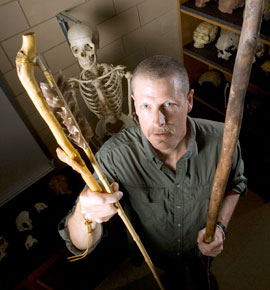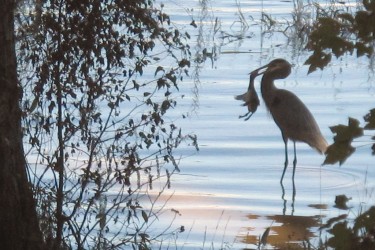This is an absorbing visualization of progress made in the past two hundred years. It seems to confirm the notion that “a rising tide lifts all boats”. He shows the relationship of wealth to health over time in a very intuitive way. His presentation allows us to “see” the benefits of the industrial revolution (early) and the agricultural “green” revolution (mid-twentieth century).
Year: 2010
Human Capacity for Killing at a Distance

Anthropologist Steven Churchill from Duke University recently gave a fascinating lecture [listen] on the discovery of projectile weapons by early Homo sapiens and subsequent effects on large carnivores (extinction!) and human evolution.
His basic premise is that sometime in the past 250,000 years humans discovered how to kill at a distance. This allowed us to crowd-out the various carnivore “gilds” including our co-evolved cousins the Neanderthals. In this photo he holds a spear-throwing projectile weapon (atlatl) in his right hand and a reproduction of a Neanderthal thrusting spear in his left.
These weapons have also had a profound effect on modern human conflicts. When we fight with thrusting weapons, the probability of injury is a linear function of the number of combatants: 0.5 with two on one, 0.33 with three on one, 0.25 with four on one, etc. So the strategy is to bring lots of friends to a fight! With projectile weapons and the function becomes exponential with the probability of injury decreasing by the square: 0.25 with two on one, 0.11 with three on one, and 0.06 with four to one!
Heron vs Grebe – Death on Lake Santa Fe
While sitting down to breakfast we witnessed this scene of “nature, red in tooth and claw.” A Great Blue Heron (Ardea herodias) had captured a Pied-Billed Grebe (Podilymbus podiceps) and was strangling it to death. The smaller bird would briefly struggle and flap its wings, but the outcome seemed certain. After a few minutes the Heron flew off with its catch. Apparently this is a common hazard for small grebes.

